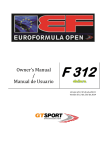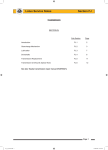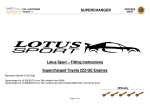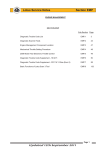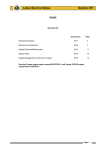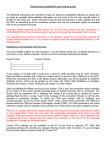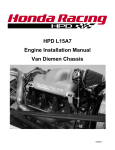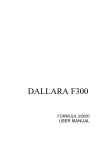Download c64/ltk-200 gearbox conversion kit `dog face engagement`
Transcript
Part Number: ALS3T0012F Version: 1 C64/LTK-200 GEARBOX CONVERSION KIT PROCESS SHEET Lotus Sport – Fitting Instructions C64/LTK-200 GEARBOX CONVERSION KIT ‘DOG FACE ENGAGEMENT’ Application Specific to S2 Elise / Exige with Toyota 2ZZ-GE Engines and C64 Transmissions Difficulty Part Number: ALS3T0012F Version: 1 C64/LTK-200 GEARBOX CONVERSION KIT PROCESS SHEET OVERVIEW The current standard car manual gearbox uses a synchromesh unit, which ensures that a smooth gear change is possible when the vehicle is in motion. The synchromesh unit consists of a system of baulk rings, tapered conical sleeves and engaging dog sleeves which ensure that the gear and engaging dog sleeve rotate at compatible speeds during the gear change process. As the synchromesh system is not deemed to be quick enough, due to the momentary pause in the baulk ring reaction in bringing the two engaging components into phase, this gearbox conversion is fitted with face dog engagement systems instead of synchromesh, which provides the driver with a quicker, more responsive gear change and a closer feel for the engine response and performance. Without synchromesh, the driver must manually perform this task of matching the speed of the gearbox input shaft to the output shaft of the gearbox. This is done on up-shifts by pausing in neutral, with the clutch out/disengaged (otherwise the engine can't affect input shaft speed) until the engine RPM has fallen sufficiently, and then completing the shift to the next higher gear. On down-shifts by pausing momentarily in neutral, releasing/disengaging the clutch and blipping the throttle to raise the engine RPM so that the gearbox input shaft speed matches the output shaft speed and then continuing to shift down. The face dog system has been designed into the production OE gearbox, which helps to keep the overall length of the internal gear pack down to a minimum length and provides a more positive gear change. This is made possible by leaving an angular clearance between the face dog and the engaging slot to ensure ease and speed of engagement, with the resultant quick, clean gear change. With this angular clearance it has essential that the design detail ensures full face contact between the dog face and the side of the mating slot when the radial clearance is taken up; this rule applies to all the engaging dogs. The angular clearance is designed by machining the dogs on the free-running gears with parallel faces, whereas the slots in the engaging dog ring are machined at an angle calculated to provide the full face contact when the clearance has been taken up in both directions of rotation. This means that in this multi-ratio gearbox, the most straightforward machining operation is carried out on the majority of components, since one engaging dog ring, with the engaging slots and their faces machined at an angle on both sides of the dog ring, is used to engage two gear ratios. The free-running gears are mounted on bearings and are in constant mesh with their respective mating gears. Though the engaging dog ring is carried on a sleeve with internal splines to locate it on the shaft and an external spline which mates with an internal spline in the dog ring, and is raised above the outside diameter of the needle roller or sleeve-type bearing, the inside diameters of these bearings run on plain portions machined at each end of the engaging dog sleeve. Thus, when assembled, two pairs of internal gears complete with bearings and an engaging dog ring are mounted on one engaging dog sleeve, whose length of external spline allows the dog ring to be placed in a central position with minimum clearance between the engaging dogs and the faces of the engaging slots on both of the freerunning gears when they are in their closer relationship. This gearbox is also fitted with a adjustable limited slip differential (LSD). The basic differential gear supplies the power to wheels which is loaded with least resistance. This allows the cars wheels to run at different speeds in a turn with least resistance. However, when a car is cornering close to its limit, the car will exhibit roll, causing the inside tires to lose forward traction and lateral grip. The wheels lift and cause excessive spin because of lack of downward force or weight distribution. This wheel spin is useless for acceleration until the tires regain traction and start to translate the power to the ground. This LSD is used to alleviate this wheel spin. The pressure plate rings have the side gear, pinion, and the pinion gear locked inside, and behind each pressure rings are a number of clutch plates. When torque is applied to the differential, the differential case will spin and throw the pinion into the pressure ring cam. The pressure ring is then pushed out against the clutch plates thereby squeezing them together. This in turn causes the wheels to gradually lock together, depending on the power applied. This effect limits the wheel spin during hard cornering and applies power to the wheels evenly when more power is applied to the wheels. On acceleration and deceleration, it provides even grip and on neutral power, it frees up for less drag and easier turning. The adjustable nature of the Lotus Sport LSD designation reflects the design of the cam groove which enables the LSD to function differently under different loads. This 1.5 way adjustable is a new term used to describe the 2 way cam which enables different lock up rates during the two directional forces. The 1.5 distributes positive lock stronger under Part Number: ALS3T0012F Version: 1 C64/LTK-200 GEARBOX CONVERSION KIT PROCESS SHEET acceleration than when decelerating. This 1.5 way provides more forgiving balance when braking than a full 2 way setup, although it is less effective for true racing applications, it provides easier operation for beginners in throttle off conditions. This LSD is 1.5-way selective, but can optionally be switched over to a 2-way without any additional parts. WARNING / NOTES The Limited Slip Differential will require adjustment after 31,000 mile (50,000 km); it is recommended that the gearbox be returned to Lotus Sport for this adjustment. The transmission fluid should be changed every 12 months or 12,000 mile, whichever is first. If undertaking extensive track days the service interval is to be decreased. The gear kit internals should be inspected for damage every 500-track miles. Although it should be possible to feel any damage when shifting, if the shift feels smooth no damage should be present. Where the shift is not smooth or there is any trouble selecting a gear, the gearbox should be inspected straight away. The standard Lotus Sport running-in procedure is to be followed for 500 mile following the installation of the gear kit. The longevity of the gear kit will be determined almost certainly by driver technique during shifting. Differences can range between, a life almost as long as a synchromesh box, to lasting just a few miles before replacement parts are needed. Do not attempt to do this modification with the engine running or when the engine is hot. All bolts should be torqued correctly – see lotus service manual for standard part or torque reference in this document. All bolts torqued should be paint marked. Ensure all necessary safety procedures are followed. Read all instructions thoroughly before commencing work and ensure all components are present. If in any doubt, consult a lotus dealer before undertaking the work. Tools Required Fork Setting Fixture ALS3T6005F All gearbox special tools as listed in Lotus Elise 111R & Exige Service Parts List A120T0325J, Function Code 60.02, page 1 & 2 C64 Manual Transaxle Repair Manual D120T0327J Lotus Elise 111R & Exige Service Notes A120T0327J Well equipped workshop including a 2-post lift, engine stand and workbench area Loctite Gasket Eliminator 518 flange sealant Synthetic Transmission Fluid – SAE 75W-90 (2.3 L required) B082F6552S (500 ml bottle) Disclaimer Lotus accepts no liability for any direct, indirect or consequential damage or loss (including as a result of negligence) arising from the application of these fitting instructions by any person. For the avoidance of doubt, this does not affect your statutory rights and Lotus does not exclude liability (if any) to you for death or personal injury arising out of Lotus’ negligence. Please note that the fitting of this kit is not covered by Lotus standard vehicle warranty. The fitting of any Lotus approved part(s) by anyone other than a Lotus approved technician may invalidate the vehicle warranty. This equipment is intended for use on private property and/or racing tracks only and is not suitable for use on public roads as it may constitute a criminal offence. Accordingly, the purchaser of the equipment and all persons who may use the equipment must ensure that it is not used on any public road. Lotus Cars Ltd cannot and does not accept any liability arising directly or indirectly from the use of the equipment other than in respect of death or personal injury caused by its negligence. The purchaser’s statutory rights when dealing as a consumer are not affected. Part Number: ALS3T0012F Version: 1 C64/LTK-200 GEARBOX CONVERSION KIT PROCESS SHEET Gear Shifting Techniques By William Hewland. July 2000 The following is some info regarding shifting gear and face dog wear. I am in the fortunate position where I have a good amount of knowledge on the subject, as I understand the mechanical side and the user (driver) side equally well. N.B. For succesful gear shifting, remember that it is critical to ensure that all mechanical elements between the drivers hand and the dog faces are in good order and properly set. This includes the gear linkage in the chassis! Successful up-shifting, (defined as fast and non dog-damaging) will be achieved by fully moving the dog ring as rapidly as possible from one gear to the next, preferably with the engine's driving load removed until the shift is completed. (The opposite is true of a synchromesh gearbox as used in passenger cars, where slow movement helps). It should be remembered that it is not possible to damage the dogs when fully engaged (in gear). The damage can only take place when initiating contact during a shift, (the `danger zone`) therefore this element must be made as short as possible. If a driver moves the gear lever slowly, or if the linkage is not rigid and effective, dog wear will occur. We always recommend lightweight yet solid rod linkage, not cables ideally. Manual. Best method: With no assistance from the engine management, the driver must lift off the throttle sufficiently to allow the dog ring to be pulled out of engagement. He should then stay off the throttle long enough to allow the dog ring to engage with the next gear. In practice, the driver can move the gear lever faster than he can move his foot off and back on to the throttle. Therefore the effective method is to apply load to the gear lever with your hand and then lift the throttle foot off and back on to the pedal as fast as physically possible. In lifting your foot, the loaded gear lever will almost involuntarily flick to the next gear before the foot is re-applied to the throttle. Another method is to load the gear lever with your hand, stay flat on the throttle and dab the clutch to release the dog ring. The overall effect on the gearshift is similar to the above method, but clutch wear may become a big issue. The worst method (most destructive and definitely slowest) is to attempt to change gear in a `passenger car / synchromesh` way, i.e. lifting off the throttle, dipping the clutch, moving the gear lever, letting the clutch up and re-instating the throttle. The method causes unnecessary clutch wear, does absolutely nothing to help come out of gear and usually causes dog wear whilst engaging the next gear. This wear is due to several reasons. Firstly, it is impossible for a driver to co-ordinate the complicated sequence of all five physical movements accurately. Consequently the engagement dogs often find themselves engaging whilst the throttle is applied. The lever is usually pulled more slowly as it was not pre-loaded, lengthening the `danger zone`. Successful downshifting has similar rules applied regarding speed of shift. Unloading the dogs is done in the opposite manner obviously. Whilst braking, the dogs must be unloaded by either touching the throttle pedal or- my preferred method- by dipping the clutch. However, one sharp dab of clutch or throttle is appropriate per shift. Continued pressure on either will cause dog damage for different reasons. `Blipping the throttle` just before engagement is advisable if the rev drops between gears are over 1300 rpm, as this will aid engagement and stabilize the car. TOP TIP for ease of downshifting: Make the downshifts as late as possible in your braking zone (i.e. at lower road speed), because the rev drops between each gear are then lower. So many drivers make the mistake of downshifting as soon as they begin braking, causing gearbox wear, engine damage and `disruption` to the driving wheels. This is a subject which can be much expanded on, but I feel that these are the basics, which I hope are of use. Part Number: ALS3T0012F Version: 1 C64/LTK-200 GEARBOX CONVERSION KIT SEQ 10 20 30 40 CAREPOINT ACTIVITY – INSTALL GEARBOX Follow Lotus Service Manual for removal of C64 Gearbox Remove clutch and assembly as per service manual Install new solid centre clutch and up rated clutch cover as per service manual Install new C64/LTK-200 gearbox, as per normal gearbox instructions. QUALITY STANDARD 10 SEQ 10 10 10 30 30 40 PART NUMBER A120T0327J RM733E RM929E ALS3Q6006F ALS3Q6000F ALS3F6002J PART DESCRIPTION Lotus Service Manual Toyota Service Manual Toyota Service Manual Clutch Solid Centre Uprated Clutch Centre C64 / LTK 200 GearBox QTY 1 1 1 1 1 1 F/C - TORQUE - PROCESS SHEET TOOLING





